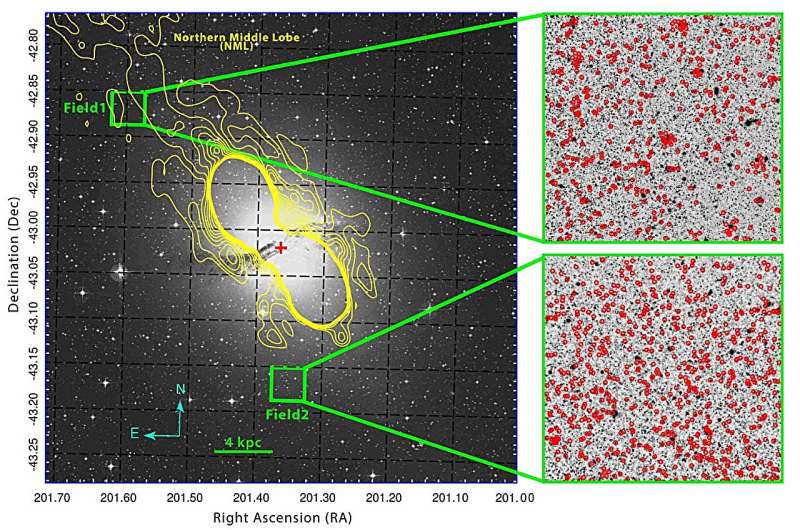June 12, 2024 report
This article has been reviewed according to Science X's editorial process and policies. Editors have highlighted the following attributes while ensuring the content's credibility:
fact-checked
preprint
trusted source
proofread
Observations explore the halo of Centaurus A

Using the Very Large Telescope (VLT) in Chile, astronomers have observed the halo of a nearby giant elliptical galaxy known as Centaurus A. Results of the observational campaign, published June 1 on the pre-print server arXiv, yield important insights into star formation history of the investigated halo.
Discovered almost two centuries ago, Centaurus A (also known as NGC 5128 or Caldwell 77) is the nearest giant elliptical galaxy—at a distance of about 12.4 million light years. It is also one of the closest radio galaxies to Earth, so its active galactic nucleus (AGN) has been extensively investigated by researchers.
Centaurus A has an extended halo and radio lobes covering almost 2 degrees of the sky in optical maps. Its extended halo has been a subject of many studies in the past, trying to investigate the galaxy's formation history, given that Centaurus A is believed to be a post-merger galaxy.
Recently, a team of astronomers led by Sima T. Aghdam of the Institute for Research in Fundamental Sciences in Tehran, Iran, has performed VLT observations of Centaurus A, aiming to better understand its origin and properties. The focus of their study was two small fields in the halo of this galaxy. By investigating variables in these two fields, they wanted to get more insights into the star formation history of Centaurus A.
"Our method is based on identifying long period variable (LPV) stars that trace their sibling stellar population and hence historical star formation due to their high luminosity and strong variability," the researchers explained.
First of all, the team identified 395 LPVs in the northeastern field, designated Field 1 (located some 61,300 light years from the center of Centaurus A), and 671 LPVs in Field 2—the southern field (about 32,300 light years from the galaxy's center).
The astronomers found that even though the two fields are located about 91,000 light years away from each other on different sides of Centaurus A, they show similar star formation histories. It turned out that in Field 1 and Field 2, star formation rates increased significantly around 3.8 billion and 800 million years ago.
The authors of the paper suppose that the latest enhanced star formation, which started about 800 million years ago, may have been a result of a merger that took place some 1 billion years ago. They added that most of the stars in the halo of Centaurus A were formed earlier than 400 million years ago.
Based on the collected results, the researchers assume that Centaurus A may have accreted a small gas-rich spiral galaxy that provided the fuel for ongoing star formation at its center. Moreover, they conclude that the intermediate-age stars came from either that accreted galaxy or may have come from a previous merger.
More information: Sima Taefi Aghdam et al, The Complex Star Formation History of the Halo of NGC 5128 (Cen A), arXiv (2024). DOI: 10.48550/arxiv.2406.00517
Journal information: arXiv
© 2024 Science X Network




















